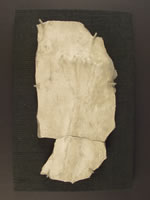The
Dominance of Land Species
(250-6 million years)
After the
Permian extinctions, marine species declined and the land species began
to thrive in the drier, more arid climate. Most species of this period
retain evidence of the segmented stem of its marine ancestors but also
show spiny leaf-like structures. The function of these spiny protuberances
is unknown—it could have been used either as a defense mechanism
or as an aid in moisture-retention.
Modern day
aquatic species are thought to have evolved 50mya from land species rather
than having direct connections to their marine ancestors.
(installation
view)
|



